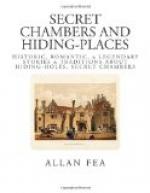One of the simplest and most secure hiding-places perhaps ever devised by a law-breaker was that within a water-butt! A cone-shaped repository, entered from the bottom, would allow a man to sit within it; nevertheless, to all intents and purposes the butt was kept full of water, and could be apparently emptied from a tap at its base, which, of course, was raised from the ground to admit the fugitive. We understand such a butt is still in existence somewhere in Yorkshire.
A “secret staircase” in Partingdale House, Mill Hill, is associated (by tradition) with the notorious Dick Turpin, perhaps because of its proximity to his haunts upon Finchley Common. As it exists now, however, there is no object for secrecy, the staircase leading merely to the attics, and its position can be seen; but the door is well disguised in a Corinthian column containing a secret spring. Various alterations have taken place in this house, so once upon a time it may have had a deeper meaning than is now perceptible.
Another supposed resort of this famous highwayman is an old ivy-grown cottage at Thornton Heath. Narrow steps lead up from the open chimney towards a concealed door, from which again steps descend and lead to a subterranean passage having an exit in the garden.
[Illustration: BOVEY HOUSE, SOUTH DEVON]
[Illustration: MAPLEDURHAM HOUSE, OXFORDSHIRE]
We do not intend to go into the matter of modern secret chambers, and there are such things, as some of our present architects and builders could tell us, for it is no uncommon thing to design hiding-places for the security of valuables. For instance, we know of a certain suburban residence, built not more than thirty years ago, where one of the rooms has capacities for swallowing up a man six feet high and broad in proportion. We have known such a person—or shall we say victim?—to appear after a temporary absence, of say, five minutes, with visible signs of discomfort; but as far as we are aware the secret is as safe in his keeping as is the famous mystery in the possession of the heir of Glamis.
An example of a sliding panel in an old house in Essex (near Braintree) was used as a pattern for the entrance to a modern secret chamber;[1] and no doubt there are many similar instances where the ingenuity of our ancestors has thus been put to use for present-day requirements.
[Footnote 1: According to the newspaper reports, the recently recovered “Duchess of Devonshire,” by Gainsborough, was for some time secreted behind a secret panel in a sumptuous steam-launch up the river Thames, from whence it was removed to America in a trunk with a false bottom.]
Our collection of houses with hiding-holes is now coming to an end. We will briefly summarise those that remain unrecorded.
“New Building” at Thirsk has, or had, a secret chamber measuring three feet by six. Upon the outside wall on the east side of the house is a small aperture into which a stone fitted with such nicety that no sign of its being movable could possibly be detected; at the same time, it could be removed with the greatest ease in the event of its being necessary to supply a person in hiding with food.




